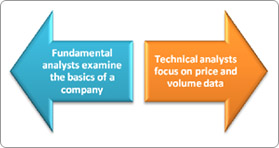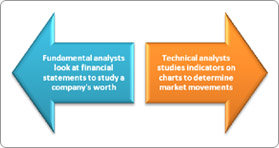| Assets Under Advice | Fees for 3years | |
| 35 lacs to 99 lacs | 3% + GST | |
| 1 Cr to 2.99 Cr | 2.5% + GST | |
| 3 Cr to 9.99 Cr | 2% + GST | |
| 10 Cr + | Customised Fees | |
| GST @ 18% | ||
|
|
||
| Please contact us for details | ||
|
|
||

We know the importance of understanding all we can about the stock market. Making decisions on what to buy and when to sell however is an entirely different ball game. While the goal of making profits is always the same, the route one takes can vary enormously.
Technical and fundamental analysis are the two approaches an investor may opt for. While both have their benefits, they are at completely opposite ends of the stock market spectrum. What sets them apart from each other is the time-frame and beliefs, but most importantly the difference is due to the methods they subscribe to.

A. The Theories
In fundamental analysis, the investor examines the financials of a company, along with any factors which may
influence the demand and supply. Fundamental investors believe that if a company has a stable foundation, it
most likely holds promise for healthy, long-term growth.
The underlying assumption is that share prices fluctuate due to investors’ mood swings and that once the
storm has settled; the market is bound to right itself. To make a profit therefore, fundamental investors set their
sights on strong companies and buy when the stock appears to be undervalued.
On the other extreme, technical analysis tends to shun the fundamental factors of a company; and instead focuses on price and volume.
Technical investors believe that the determining factors are already reflected in the price of stock. Therefore, there is no need to individually assess company fundamentals. The technical analyst decides to buy or sell based on what the trading indicators presently point to.
B. The Methods
Fundamental and technical investing both employ vastly different techniques to determine the value of stock.
In fundamental analysis, the investor starts his exploration of a company by paying close attention to the financial statements. How much money the company makes, spends or owes are all contributing factors which must be taken into account.
There are three statements of importance which you must look into while undertaking a fundamental analysis. They are the balance sheet, income statement and cash flow statement.
The balance sheet of a company speaks volumes about how the business is faring. It tells you how much it owns in terms of wealth, how much it has to repay and how much cash is still owed by the customers.
The income statement gives a clear picture of the amount of profits a company makes. Therefore it takes into account the earnings and expenses over a set period of time. The profit of a company comes down to the difference between how much amount it brings in and how much it spends on its daily upkeep.
The cash flow statement tells the fundamental analyst how much money goes in and out of the company over a period of time. Unlike the income statement, this doesn’t take into consideration the non-cash sales or expenses. When a company has free cash flow, it signifies that it will be easier to pay back the money it owes.

Analysing Charts in Technical Analysis
The technical analyst uses a variety of indicators on share price charts to represent market movement over time. The
focus here is on price and volume, which the technical analyst believes are all you need to determine future worth.
The charts are useful for highlighting where prices are impacted, while indicating future scope. This is done by
using indicators, which compare different averages to point to either an uptrend or downtrend. While the use of
these charts helps the technical analyst to effectively trace the variations, the speed with which the changes occur
can be a factor in missing out on profits.

C. Time-Frame
In fundamental analysis, the focus is on long-term investments. Studying the financials of a company not only takes
time, but for the basics to be reflected in the outcome it is also a long-winded process. With fundamental analysis
the goal is to wait for the company to reach its intrinsic worth, which it might take a number of years to attain.
With technical analysis though, the investor prefers to make quick money, rather than waiting indefinitely to make a
bigger profit. Since technical analysts don’t believe in the concept of intrinsic worth, the charts are enough for
them to make decisions on the spot.

Pros And Cons
Fundamental analysis generates praise for the ease of process. The data is not only easy to obtain, but it is fairly simple for an investment beginner to understand the basics through the financial records. Another advantage is that a fundamental analyst subscribes to value investing, which ensures he profits by buying an undervalued stock. More importantly fundamental analysis makes it easier to tell when alarm bells are ringing and it’s time to pull out of your shares.
On the downside, there is never any guarantee that the price of stock will right itself. It is merely a prediction which might never stake its claim. The research involved in fundamental analysis can also be a time consuming affair.

With technical analysis, the charts and indicators help to spot patterns which make it easier to recognize the trends. The comparison between the past and present prices allows the investor to determine which direction the stock is likely to take. The problem with technical analysis though is that the indicators are often hard to understand. The investor also tends to miss out on higher profits by employing this trading technique.
 To Conclude
To ConcludeWhile fundamental analysis has proved to be the general preference, there are also advantages to the technical approach. Some investors have combined the two to calculate timing while adhering to the basics. Though both approaches seem at opposite ends, if you take the value of both into account you can benefit through the blend.